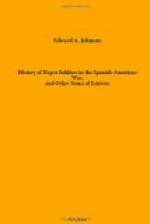The description which follows is interesting: “It was simply grand to see how those young fellows, and old fellows, too, men who were rich and had been the petted of society in the city, walk up and down the lines while their clothes were powdered by the dust from exploding shells and torn by broken fragments cool as could be and yelling to the men to lay low and take good aim, or directing some squad to take care of a poor devil who was wounded. Why, at times there when the bullets were so thick they mowed the grass down like grass cutters in places, the officers stood looking at the enemy through glasses as if they were enjoying the scene, and now and then you’d see a Captain or a Lieutenant pick up a gun from a wounded or dead man and blaze away himself at some good shot that he had caught sight of from his advantage point. Those sights kind of bring men together and make them think more of each other. And when a white man strayed from his regiment and falls wounded it rather affects him to have a Negro, shot himself a couple of times, take his carbine and make a splint of it to keep a torn limb together for the white soldier, and then, after lifting him to one side, pick up the wounded man’s rifle and go back to the fight with as much vigor as ever. Yes, sir, we boys have learned something down there, even if some of us were pretty badly torn for it.”
Another witness testifies: “Trooper Lewis Bowman, another of the brave Tenth Cavalry, had two ribs broken by a Spanish shell while before San Juan. He told of the battle as follows:”
“’The Rough Riders had gone off in great glee, bantering up and good-naturedly boasting that they were going ahead to lick the Spaniards without any trouble, and advising us to remain where we were until they returned, and they would bring back some Spanish heads as trophies. When we heard firing in the distance, our Captain remarked that some one ahead was doing good work. The firing became so heavy and regular that our officers, without orders, decided to move forward and reconnoitre When we got where we could see what was going on we found that the Rough Riders had marched down a sort of canon between the mountains. The Spaniards had men posted at the entrance, and as soon as the Rough Riders had gone in had about closed up the rear and were firing upon the Rough Riders from both the front and rear. Immediately the Spaniards in the rear received a volley from our men of the Tenth Cavalry (colored) without command. The Spaniards were afraid we were going to flank them, and rushed out of ambush, in front of the Rough Riders, throwing up their hands and shouting, ’Don’t shoot; we are Cubans.’”
“The Rough Riders thus let them escape, and gave them a chance to take a better position ahead. During all this time the men were in all the tall grass and could not see even each other and I feared the Rough Riders in the rear shot many of their men in the front, mistaking them for Spanish soldiers. By this time the Tenth Cavalry had fully taken in the situation, and, adopting the method employed in fighting the Indians, were able to turn the tide of battle and repulse the Spaniards.”




